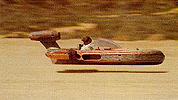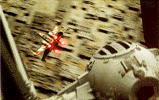Spotlight : April 1997
Star Wars Strikes Back
by Todd Vaziri
Spotlight : April 1997
Star Wars Strikes Back
by Todd Vaziri
The first quarter of 1997 has been an exciting one for
Hollywood.
Audiences have already seen many major films released, including Howard
Stern's PRIVATE PARTS, Jim Carrey's LIAR LIAR, the effects-laden THE RELIC,
TURBULENCE and DANTE'S
PEAK. The pre-summer lineup includes two huge
productions: Paramount's THE SAINT and Fox's VOLCANO.
But undoubtedly, the films that have received the most attention have been
the films of the recently re-released STAR WARS
trilogy. No one could
escape from the tidal wave of publicity that surrounded the pictures.
Countless interviews with George Lucas, TV specials, fast-food tie-in
promotions... and then there was the merchandising.
The re-release of STAR WARS took everyone by surprise at the box office.
The film cleaned up in theatres, quickly surpassing the $100 million mark.
Both THE EMPIRE STRIKES BACK and RETURN OF THE JEDI were #1 at the box
office their respective weeks.
Now that a few weeks has passed since the release of JEDI, and the media
hype has died down, it is easier to take a broader look at this latest STAR
WARS phenomenon, and answer some very tough questions.
How will the Special Editions be looked upon by film and visual effects
historians? As an attempt to revitalize a classic film series? Or as a
moneymaking scheme that greatly upsets film purists?
Unfortunately, I cannot take a stand either way. I have feelings for both
sides. I feel that the Special Edition was a tremendous opportunity to
enhance these great films, and make them look like contemporary visual
effects films. I also feel that George Lucas is betraying the efforts of
the original effects artists, and that the enhancements were quite
unnecessary.
As a result, here are two very different commentaries on this subject:
by Todd Vaziri
The STAR WARS Trilogy marked an enormous milestone in film history. Modern
visual effects pioneers like John Dykstra, Dennis Muren, Richard Edlund,
revolutionized the way bluescreen composites could look. Their
computer-controlled camera allowed the artists to program moves never
achieved before. Talented creature creators produced alien races that only
previously existed in their imaginations. Why betray their efforts by
giving STAR WARS a facelift?
Do these films need a facelift? Absolutely not. Once a piece of art has
been established as being 'complete,' it is untouchable.
Was that new Jabba sequence really necessary? It was a badly written scene
to begin with. The dialogue echoes the previous discussion Han had with
Greedo, almost verbatim. Too many complications are involved with the
Jabba sequence, also. Why has Jabba lost about half his mass, and is three
feet shorter than Han? Because the eyelines had to be consistent--Harrison
Ford's eyeline was ruled out being altered, and the actor portraying Jabba
in the original footage was a short, fat man. The new Jabba is NOT the
same Jabba we see in RETURN OF THE JEDI. In addition, the Jabba in JEDI
had extremely limited mouth movements--essentially, his mouth simply opened
and closed. The new computer generated Jabba is waaay to expressive,
almost more expressive than Harrison Ford in the scene. Why? Because
accurate computer generated lip-synch and facial expressions are a reality
at ILM these days. But just because it CAN be done, doesn't mean it SHOULD
be done. The new Jabba is a remarkable CG achievement, but he betrays the
Jabba we've all grown up with.
I'm not saying that the restoration process was wrong--I'm a staunch film
preservationist. Recompositing effects sequences via both optical and
digital means was certainly necessary for preservation purposes. However,
enhancing or creating new scenes altogether is something quite different
than preserving a classic film.
This is not the case of a director restoring the original cut of his film
(Ridley Scott's cut of BLADE RUNNER). This is not the case of a director
telling an expanded version of his story (James Cameron's THE ABYSS, ALIENS
and T2). This is a case of not letting a classic remain a classic. This
is a case of experimentation.
Lucas is a huge fan of experimentation. Producer Rick McCallum and Lucas have both
stated on numerous occasions that RADIOLAND MURDERS and "The Young Indiana Jones
Chronicles" were both test-beds for advances in digital compositing. And they've also
stated that the Special Edition trilogy is a test-bed for the STAR WARS prequels. Is
this right? Should these classics have been chopped up to serve as test comps for the
prequels? I don't think so.
Remember the new shot in STAR WARS on Tatooine that pans almost 360 degrees
and cranes from ground level to dozens of feet in the air? That shot did
NOT fit well into the film. The original STAR WARS contained hardly any camera
movement, and this new shot is quite anachronistic.
The Special Edition of STAR WARS is no longer the classic is has always
been. Lucas as stated that the version of the film he wants remembered is
the Special Edition. This betrays the efforts of the original artists, and
throws a wrench into the art form of cinema.
by Todd Vaziri
Many current visual effects artists were inspired by the jaw-dropping visuals of the
original STAR WARS. The film revitalized the effects industry, and revitalized a
sagging Hollywood box office.
I can't think of a more special opportunity than to work with the original elements of
a science-fiction classic and adding new digital magic.
Lucas has claimed that he always wanted to replace the human Jabba The Hutt shot in
1977 with a puppet in post-production, but ran out of time and money to complete his
vision. This is an enormous opportunity--to work with twenty year old footage,
erasing a human character and inserting a new CG character.
Today, when background plates are shot that will eventually contain CG imagery, dozens
of detailed notes are taken. This means records of the practical lighting setup,
exact measurements of the camera in relation to the principles, lenses, camera
movements, etc. The accuracy of the CG image looking like it truly belongs into the
scene depends on the match-moving. The more data given to the match-mover (the
virtual cameraman) and the CG lighting crew, the more real the scene appears. Nearly
none of this data was accessible to the CG artists on the Special Edition.
Experimentation, trial and error, and creative juices helped the match-movers and CG
lighting crew do a splendid job recreating those 1977 shots, especially with the Jabba
sequence.
Although the Special Edition wasn't completely necessary to produce, the opportunity
to work on twenty year old footage and enhance a sci-fi classic was too great an
opportunity to pass up.
Back to the main STAR WARS page
The Special Edition:
Who Needs It?
 Enhancing or altering one sequence begs the questions--where does it end?
If ILM created a CG Jabba, why didn't they replace the Rancor? If ILM
added a computer generated Sarlacc, why not replace the Tauntauns? The
Rancor and Tauntauns were shining examples of techniques which were highly
respected at the time, but appear out of date to today's audiences.
Enhancing or altering one sequence begs the questions--where does it end?
If ILM created a CG Jabba, why didn't they replace the Rancor? If ILM
added a computer generated Sarlacc, why not replace the Tauntauns? The
Rancor and Tauntauns were shining examples of techniques which were highly
respected at the time, but appear out of date to today's audiences.
The Special Edition: A Once
In A Lifetime Opportunity
 The effects challenge of the Special Edition was a unique one: to integrate
new computer generated imagery into background plates shot twenty years earlier.
The effects challenge of the Special Edition was a unique one: to integrate
new computer generated imagery into background plates shot twenty years earlier.
 The expansion of Mos Eisley, the Coruscant celebration sequence, and the
streamlining of the Death Star battle must have been an absolutely exciting project on
which to work. The joy of enhancing a classic film so that contemporary audiences can
clearly follow the action is what fueled ILM artists.
The expansion of Mos Eisley, the Coruscant celebration sequence, and the
streamlining of the Death Star battle must have been an absolutely exciting project on
which to work. The joy of enhancing a classic film so that contemporary audiences can
clearly follow the action is what fueled ILM artists.
Apparently, my CON argument is more elaborate than my PRO argument. Clearly, I am
more against the Special Edition than for it. The bottom line is that the Special
Edition has made a lot of money for Fox and Lucasfilm, and has helped ILM artists
prepare for the mind-blowing visual effects that will arrive with the STAR WARS
prequels.

. . VFX HQ Produced by Todd Vaziri . . http://www.vfxhq.com . . e-mail: tvaziri@gmail.com . .
All text Copyright © 1998 Todd Vaziri, unless otherwise noted